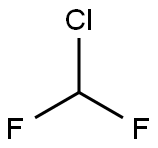2-CHLORO-2,2-DIFLUOROACETOPHENONE
Synonym(s):α-Chloro-α,α-difluoroacetophenone;2-Chloro-2,2-difluoro-1-phenylethanone;Chlorodifluoromethyl phenyl ketone
- CAS NO.:384-67-8
- Empirical Formula: C8H5ClF2O
- Molecular Weight: 190.57
- MDL number: MFCD00042123
- EINECS: 621-031-1
- SAFETY DATA SHEET (SDS)
- Update Date: 2024-01-25 15:58:02

What is 2-CHLORO-2,2-DIFLUOROACETOPHENONE?
Description
Novel and non-ODS-based (ODS = ozone-depleting substance) difluorocarbene reagents for O- and N-difluoromethylation. PhCOCF2Cl reacts with a variety of structurally diverse phenol derivatives to produce aryl difluoromethyl ethers in good yields. PhSO2CF2Cl can react with a variety of structurally diverse phenol derivatives and N-heterocyclic compounds.
The Uses of 2-CHLORO-2,2-DIFLUOROACETOPHENONE
2-Chloro-2,2-difluoroacetophenone can be used:
- As a reagent in the difluoromethylation of various phenols to yield aryl difluoromethyl ethers.
- As a precursor in the Baylis-Hillman reaction of fluoroalkyl ketones to obtain chlorodifluoromethyl containing products.
- As a substrate in the synthesis of propargyl alcohols using a novel ruthenium catalyst.
General Description
2-Chloro-2,2-difluoroacetophenone is a difluorocarbene reagent, which is generally used in the synthesis of 2,2-difluoro enol silyl ethers, and gem?-difluoromethene derived compounds.
Properties of 2-CHLORO-2,2-DIFLUOROACETOPHENONE
| Melting point: | 102-103 °C |
| Boiling point: | 94-96 °C35 mm Hg(lit.) |
| Density | 1.293 g/mL at 25 °C(lit.) |
| refractive index | n |
| Flash point: | 163 °F |
| storage temp. | Keep in dark place,Inert atmosphere,Room temperature |
| solubility | Difficult to mix. |
| color | Clear, colourless |
| BRN | 2251448 |
| CAS DataBase Reference | 384-67-8(CAS DataBase Reference) |
Safety information for 2-CHLORO-2,2-DIFLUOROACETOPHENONE
| Signal word | Warning |
| Pictogram(s) |
 Exclamation Mark Irritant GHS07 |
| GHS Hazard Statements |
H315:Skin corrosion/irritation H319:Serious eye damage/eye irritation H335:Specific target organ toxicity, single exposure;Respiratory tract irritation |
| Precautionary Statement Codes |
P261:Avoid breathing dust/fume/gas/mist/vapours/spray. P264:Wash hands thoroughly after handling. P264:Wash skin thouroughly after handling. P271:Use only outdoors or in a well-ventilated area. P280:Wear protective gloves/protective clothing/eye protection/face protection. P302+P352:IF ON SKIN: wash with plenty of soap and water. P305+P351+P338:IF IN EYES: Rinse cautiously with water for several minutes. Remove contact lenses, if present and easy to do. Continuerinsing. |
Computed Descriptors for 2-CHLORO-2,2-DIFLUOROACETOPHENONE
New Products
(S)-3-Aminobutanenitrile hydrochloride 4-Methylphenylacetic acid N-Boc-D-alaninol N-BOC-D/L-ALANINOL Tert-butyl bis(2-chloroethyl)carbamate 3-Morpholino-1-(4-nitrophenyl)-5,6-dihydropyridin- 2(1H)-one Furan-2,5-Dicarboxylic Acid Tropic acid 1-Bromo-3,5-Di-Tert-Butylbenzene S-2-CHLORO PROPIONIC ACID ETHYL ISOCYANOACETATE 2-Bromo-1,3-Bis(Dimethylamino)Trimethinium Hexafluorophosphate 4-IODO BENZOIC ACID 3-NITRO-2-METHYL ANILINE 1-(2,4-DICHLOROPHENYL) ETHANAMINE (2-Hydroxyphenyl)acetonitrile 4-Bromopyrazole 2-(Cyanocyclohexyl)acetic acid 4-methoxy-3,5-dinitropyridine 1-(4-(aminomethyl)benzyl)urea hydrochloride 2-aminopropyl benzoate hydrochloride diethyl 2-(2-((tertbutoxycarbonyl)amino) ethyl)malonate tert-butyl 4- (ureidomethyl)benzylcarbamate Ethyl-2-chloro((4-methoxyphenyl)hydrazono)acetateRelated products of tetrahydrofuran




![N-tert-Butyldimethylsilyl-2-[S-(fluoromethyl)sulfonimidoyl]pyridine, 98%](https://img.chemicalbook.in/CAS/20200401/GIF/2050545-76-9.gif)



You may like
-
 2-Chloro-2,2-difluoroacetophenone CAS 384-67-8View Details
2-Chloro-2,2-difluoroacetophenone CAS 384-67-8View Details
384-67-8 -
 2-Chloro-2,2-difluoroacetophenone CAS 384-67-8View Details
2-Chloro-2,2-difluoroacetophenone CAS 384-67-8View Details
384-67-8 -
 1975-50-4 98%View Details
1975-50-4 98%View Details
1975-50-4 -
 2-HYDROXY BENZYL ALCOHOL 98%View Details
2-HYDROXY BENZYL ALCOHOL 98%View Details
90-01-7 -
 2-Chloro-1,3-Bis(Dimethylamino)Trimethinium Hexafluorophosphate 221615-75-4 98%View Details
2-Chloro-1,3-Bis(Dimethylamino)Trimethinium Hexafluorophosphate 221615-75-4 98%View Details
221615-75-4 -
 61397-56-6 CIS BROMO BENZOATE 98%View Details
61397-56-6 CIS BROMO BENZOATE 98%View Details
61397-56-6 -
 14714-50-2 (2-Hydroxyphenyl)acetonitrile 98+View Details
14714-50-2 (2-Hydroxyphenyl)acetonitrile 98+View Details
14714-50-2 -
 118753-70-1 98+View Details
118753-70-1 98+View Details
118753-70-1
Statement: All products displayed on this website are only used for non medical purposes such as industrial applications or scientific research, and cannot be used for clinical diagnosis or treatment of humans or animals. They are not medicinal or edible.